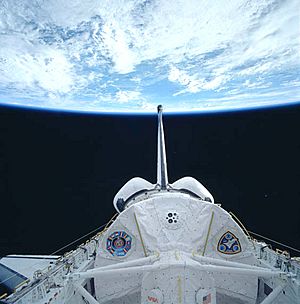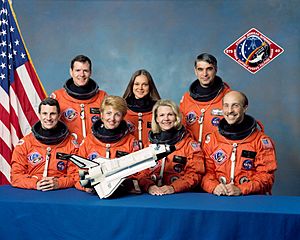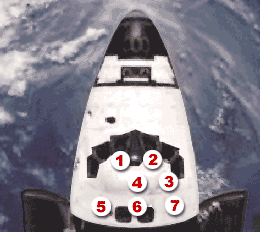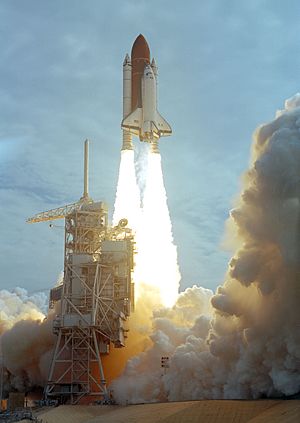STS-40 facts for kids

Spacelab Module LM1 in Columbia's payload bay, serving as the Spacelab Life Sciences laboratory
|
|
| Names | Space Transportation System-41 |
|---|---|
| Mission type | Spacelab Life Sciences-1 (SLS-1) |
| Operator | NASA |
| Mission duration | 9 days, 2 hours, 14 minutes, 20 seconds (achieved) |
| Distance travelled | 6,083,223 km (3,779,940 mi) |
| Orbits completed | 146 |
| Spacecraft properties | |
| Spacecraft | Space Shuttle Columbia |
| Launch mass | 114,290 kg (251,970 lb) |
| Landing mass | 102,283 kg (225,495 lb) |
| Payload mass | 12,374 kg (27,280 lb) |
| Crew | |
| Crew size | 7 |
| Members |
|
| Start of mission | |
| Launch date | 5 June 1991, 13:24:51 UTC |
| Rocket | Space Shuttle Columbia |
| Launch site | Kennedy Space Center, LC-39B |
| Contractor | Rockwell International |
| End of mission | |
| Landing date | 14 June 1991, 15:39:11 UTC |
| Landing site | Edwards, Runway 22 |
| Orbital parameters | |
| Reference system | Geocentric orbit |
| Regime | Low Earth orbit |
| Perigee | 287 km (178 mi) |
| Apogee | 296 km (184 mi) |
| Inclination | 39.02° |
| Period | 90.40 minutes |
 STS-40 mission patch  Back row: Bryan D. O'Connor, Tamara E. Jernigan, Sidney M. Gutierrez Front row: F. Drew Gaffney, Millie Hughes-Fulford, Margaret Rhea Seddon, James P. Bagian |
|
STS-40 was an exciting nine-day space mission in June 1991. It was the eleventh flight for the Space Shuttle Columbia. This mission carried a special science laboratory called Spacelab. It was the first Spacelab mission completely focused on biology and how living things react to space. STS-40 also made history as the first spaceflight with three women astronauts on board!
Contents
Meet the STS-40 Crew
The STS-40 mission had a team of seven brave astronauts. They worked together to perform important science experiments in space.
| Position | Astronaut | |
|---|---|---|
| Commander | Bryan D. O'Connor Second and last spaceflight |
|
| Pilot | Sidney M. Gutierrez First spaceflight |
|
| Mission Specialist 1 | James P. Bagian Second and last spaceflight |
|
| Mission Specialist 2 | Tamara E. Jernigan First spaceflight |
|
| Mission Specialist 3 | Margaret Rhea Seddon Second spaceflight |
|
| Payload Specialist 1 | F. Drew Gaffney Only spaceflight |
|
| Payload Specialist 2 | Millie Hughes-Fulford Only spaceflight |
|
Where the Crew Sat
The astronauts had specific seats for launch and landing. Some sat on the flight deck, which is like the cockpit. Others sat on the middeck, which is a living and working area.
| Seat | Launch | Landing |
Seats 1–4 are on the Flight Deck. Seats 5–7 are on the Middeck. |
|---|---|---|---|
| S1 | O'Connor | O'Connor | |
| S2 | Gutierrez | Gutierrez | |
| S3 | Bagian | Seddon | |
| S4 | Jernigan | Jernigan | |
| S5 | Seddon | Bagian | |
| S6 | Gaffney | Gaffney | |
| S7 | Hughes-Fulford | Hughes-Fulford |
Mission Journey and Discoveries
The launch of STS-40 was originally planned for May 22, 1991. However, it was delayed a few times. Engineers found some small issues with parts in the shuttle's fuel system. They also had to fix a computer and other controls. After these important repairs, the mission successfully launched on June 5, 1991. The Columbia weighed about 114,290 kilograms at launch. This amazing launch was even filmed for an IMAX movie called Journey to Space.
This mission was super important for science. It was the fifth time a Spacelab module flew, but the first time it was completely dedicated to studying life in space. The astronauts performed detailed experiments, similar to those done on the Skylab missions in the 1970s.
Who and What Was Studied
The scientists studied humans, 30 rodents (like mice), and thousands of tiny jellyfish. The main goal was to understand how space affects living bodies.
The experiments focused on six main body systems:
- Heart and Lungs: How the cardiovascular system works in space.
- Kidneys and Hormones: How the renal and endocrine systems adapt.
- Blood: Changes in blood plasma.
- Immune System: How the body's defenses react to microgravity.
- Muscles and Bones: How the musculoskeletal system changes.
- Brain and Nerves: How the neurovestibular system (balance and senses) is affected.
Besides these main studies, the shuttle also carried other experiments. These included Getaway Special (GAS) canisters for testing materials, plants, and cosmic radiation. There was also an experiment called MODE to study how things move in zero gravity.
Landing Back on Earth
After nine days in space, the Columbia landed safely on June 14, 1991. It touched down on Runway 22 at Edwards Air Force Base in California. The shuttle then returned to the Kennedy Space Center a week later.
Space Wake-Up Calls
NASA has a fun tradition of playing music to wake up astronauts in space. This started during the Project Gemini program. Each song is chosen carefully, often by the astronauts' families. The songs usually have a special meaning to one of the crew members or relate to their daily tasks.
| Day | Song | Artist/Composer | Played For |
|---|---|---|---|
| Day 2 | Great Balls of Fire | Jerry Lee Lewis | |
| Day 3 | A Military medley | O'Connor, Gutierrez | |
| Day 4 | Yakety Yak | The Coasters | |
| Day 5 | Greetings from the crews' children Somewhere out there from the film "An American Tail" | ||
| Day 6 | "Cow Patty" | Tammy Jernigan | |
| Day 7 | "Shout - The Faber College Theme" from the movie "Animal House" | Otis Day and the Knights | |
| Day 8 | "Twistin' the Night Away" from the movie, "Animal House" | Sam Cooke | |
| Day 9 | Chain Gang | The Nylons | |
| Day 10 | What a Wonderful World | Louis Armstrong |



